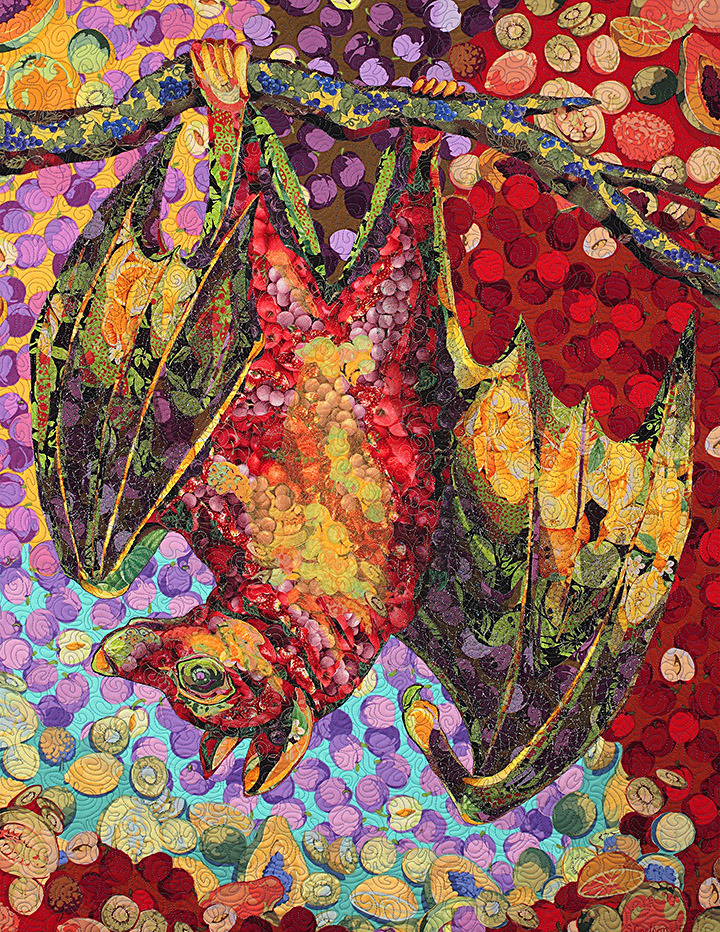
Some quilts have complex and rich origin stories. They have a long incubation and are the product of lots of “dream time.”
Others not so much.
“Fructos” is one of those others. Here’s what I wrote for the International Quilt Festival where the quilt will appear in my “Specimens” special exhibit this November.
The 16th Century portraits by Giuseppe Arcimboldo of Italy used images of fruits and vegetables to create faces. I’ve always been amused and fascinated by them. So when I was looking at a stack of fruit and vegetable patterned novelty fabric (where did they all come from?) a thought started to form. Noticing I had some great fruit prints in awesome colors, the next thought was “bat,” as in “fruit bat.” In researching fruit bats, I learned that their habitat is shrinking due to human population growth. These bats are also know as “flying foxes,” no stretch to the imagination when you examine their faces. They eat exclusively fruit and play a large part in the pollination of the fruit trees. They need to be honored for this service they provide to their ecosystem. My specimen is made up entirely of fruit-printed fabrics and in the style of centuries-old scientific drawings.

Other than that, there’s not a whole lot more to say about the origin of “Fructos.”
In our previous home, we had bats that lived in the eaves. Not everyone loves bats, but we would sit out on our deck at twilight to watch them swooping and scooping up mosquitoes, which we thought was pretty neat. After “Tickled Pink” I made a list of other possible “Specimens” quilts. When the idea of a fruit bat came up, it went onto the list. It’s that simple, really.
“Fructos” was started immediately after “Gombessa,” and like that quilt the photo documentation of its creation is poor. (Au revoir, perfectionism!) I have a few photographs of the early on stages, but none (that I can find at least) as the quilt progresses beyond the beginning, so I can’t tell the whole story of making the quilt. But I’ll still attempt to provide some insights for you.
So here’s the beginning. I’ve gathered those novelty fruit fabrics and grouped them a bit by color and a bit by value. Until I saw these photos again, I had forgotten that I had thought the black and white picnic fabric would be a good background. Cool fabric no doubt, and the reverse is just as interesting—very painterly.
But there’s a reason I have my students wait to pick out a background before they’ve even begun their collage. It’s because it gets in the way. You don’t want to glue directly on it—you might want to change something down the road, and in the meantime it distorts your perception of the fabrics you are working with at the moment. It may influence your fabric choices, and there’s no way you could know if it’ll even be the best background yet.
Still, this is how I started “Fructos” ten years ago.
I have fabrics assembled and I my reference image pinned right there on the board. The etching of a fruit bat was taken from a book of copyright free images—quite possibly by Dover Publications—a good resource.
Then it’s time to play. I quickly grouped the folded fabric to give myself an idea how it might work. Did I have good color and value ranges? Were there any gaps? By chance did I need to buy more fabric???
Then the design. I needed to lay down some plain fabric as a foundation to sketch and then glue onto—first using pencil, then colored pencils for the edits, then a Sharpie marker for the final version.
I use the printed image(s) as guides for the drawing stage, and as reference for shadows and highlights to create the form later. In this case, as in many, I eye-ball the sketching process. In other cases such as “Dixie Dingo Dreaming”, and in classes, I show how to create the line drawing by tracing and then enlarging the pencil drawing.
OK, so now we’re getting into the cringe-worthy part of this blog. Past students of mine will get this, and may have already noticed. It’s the use of such big, space-filling pieces of fabric. Ack! It’s exactly what I tell them not to do. Do as I say and not what I do… though keep in mind this was ten years ago. We all change and evolve.
Well, here it is, and posted for all to see. I admit it, I was seduced by the lure of filling large spaces quickly. Just pay attention to what happens toward the end.
Note how I left gaps (see above) between the finger-bone ridges of the bat wings. That made it much easier to slip wider pieces of yellow fabric (see below) under the green edges, creating lines of highlights, rather than cutting extremely narrow strips of yellow fabric to glue on top of the green.
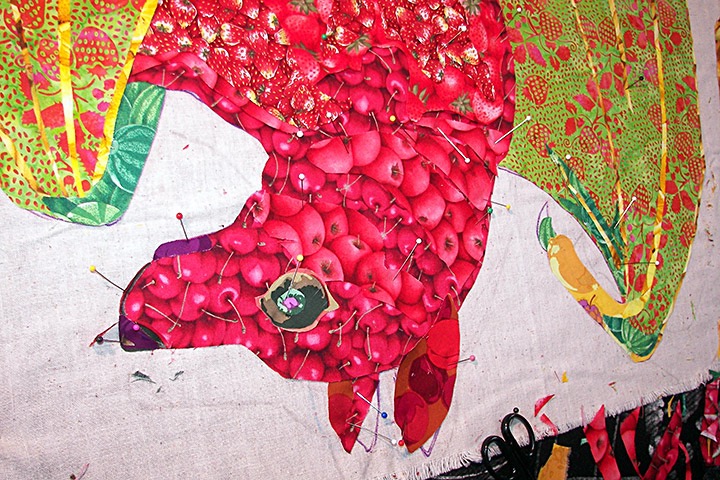
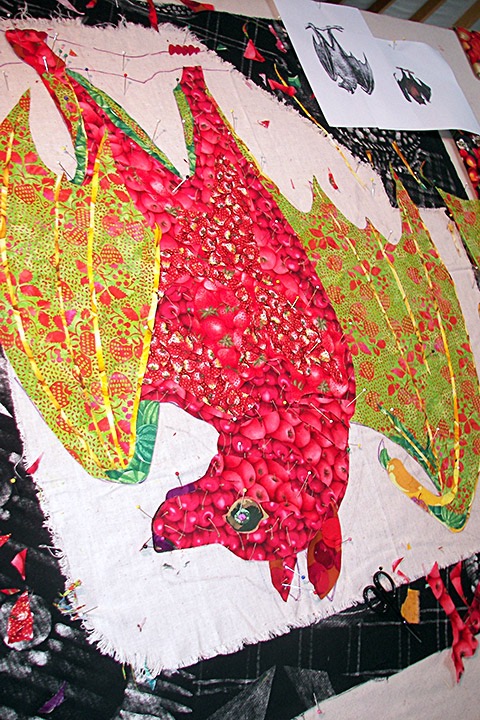
And here’s where my progress photos end. With obviously many more alterations to come, though all undocumented.
I repeated the final quilted image below so you can easily compare with the photos above. Almost all the original cherry and lime green strawberry fabrics are covered up—remember how I said to take note of those fabrics in the finished piece? That’s why I now say (and do) start with smaller pieces—much easier to blend and merge together—’cause that’s where you’ll want to be in the end anyway.
But even with that debatable start, I like this fellow. I like his banana toes, I like his branch of grapes, and I love the luscious plums and papayas in the background—a far cry from that original black and white background. You can’t really tell on the photo, but there’s sparkle in the black netting that is used for shadowing on his wings, and a shimmer in the yellow organza providing a highlight on his belly.
However, considering the lack of history for this piece, the best story to relate concerning “Fructos” isn’t how it was made or what inspired it, but how difficult it is for my husband, Tom, to accept the existence of this quilt.
All Art Is Good Art
I assume that all couples needle one another once in a while. There is little as sure to start an interesting conversation than when I claim that “All art is good art.” While he is rabidly supportive both of me and of my students and certain other artists—such as his landscape-painter mother—Tom does think that some art is “better” than other art.
I don’t truly believe that all art is good art. It’s just a handy way of expressing a more complex idea: When someone puts effort into it, all art is worthwhile and should be accepted on its own merits rather than being compared to other work. I have little patience for art without heart.
Tom is not a fan of “Fructos.” Actually, that’s probably not expressing his feelings strong enough. See, he never like those old paintings of portraits formed with fruits and vegetables. Me? I could stare at them for hours. Let’s just say it’s never been his cup of tea. Everyone, he concedes, has their own opinion.
In any case, this quilt accomplishes what I set out to do. Like when I used only scraps to create “Samuelsaurus Rex” and Marabou Stork, or using only Australian Aboriginal fabrics in “Dixie Dingo Dreaming,” limiting myself to using only fruit novelty fabrics in “Fructos” both focused the work and challenged my creativity.
Meanwhile, Tom’s mom, Sylvia, LOVES the piece. So she now has ownership of it. It hangs on her living room wall. As I like to say, it’s there for Tom to “enjoy” whenever he visits his mom. But it seems to make her very happy, which Tom truly appreciates.
Beauty is in the eye of the beholder, so they say. I say: All art is good art. But it’s the effort that counts. I see it in my classes and part of my job is to let go of any prejudices about what makes “good” art and find the unique artist within. Maybe not all art is great art. But seen from the right perspective, all art is certainly worthwhile.
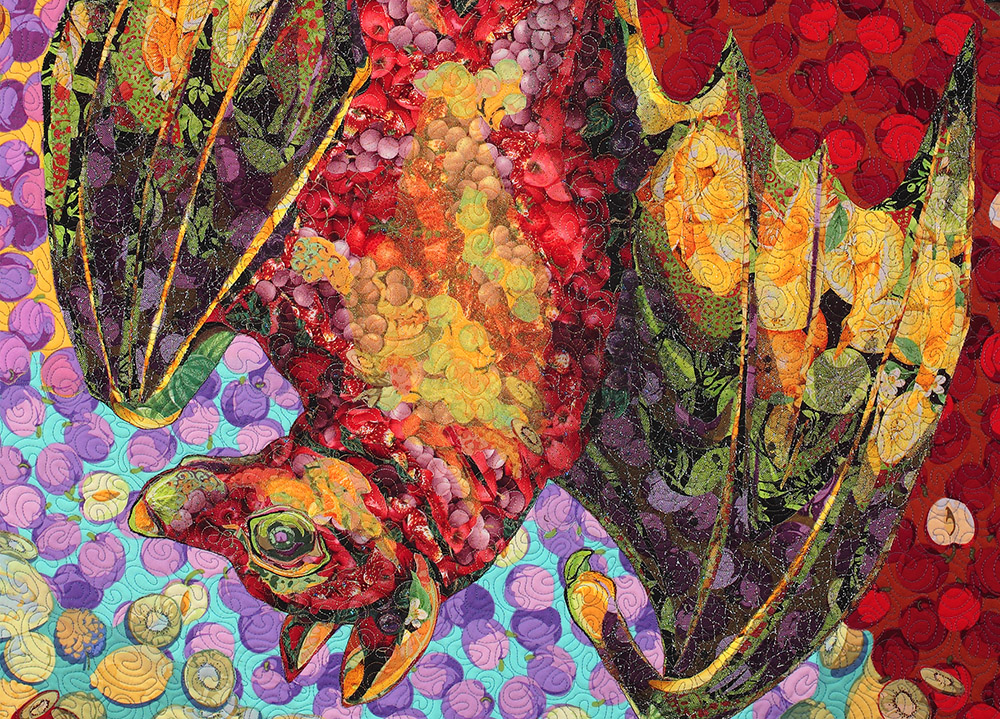
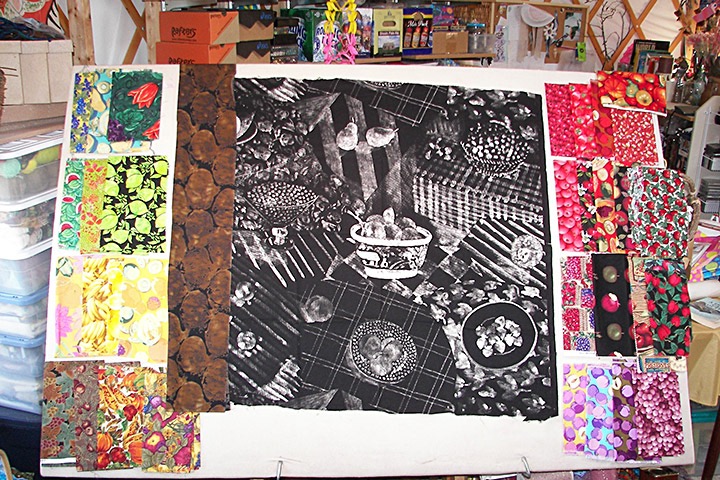
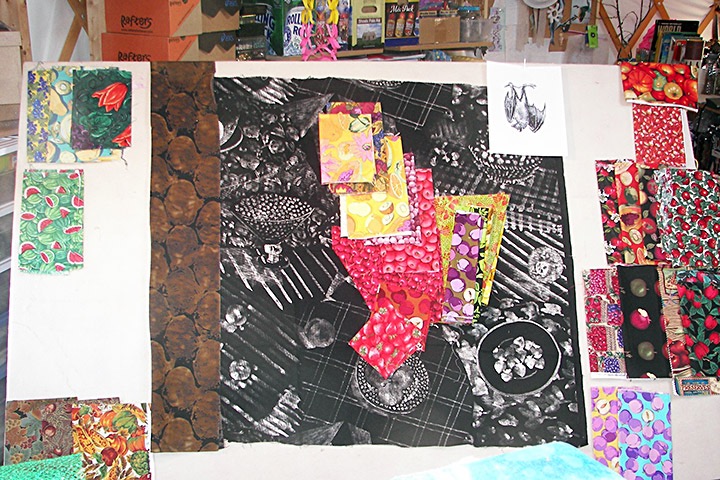
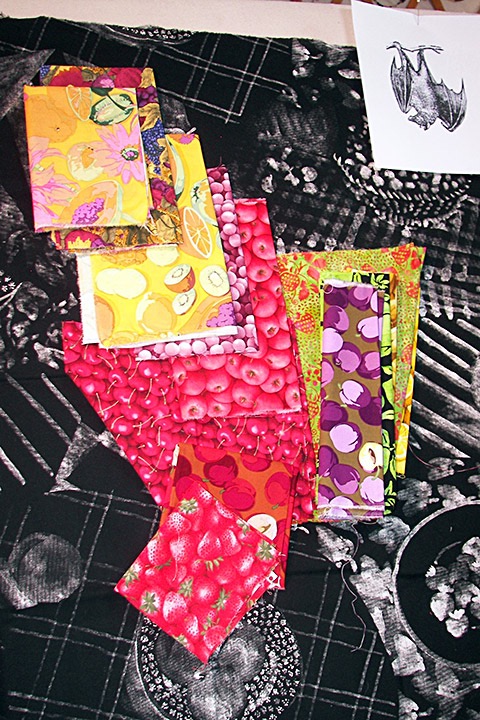
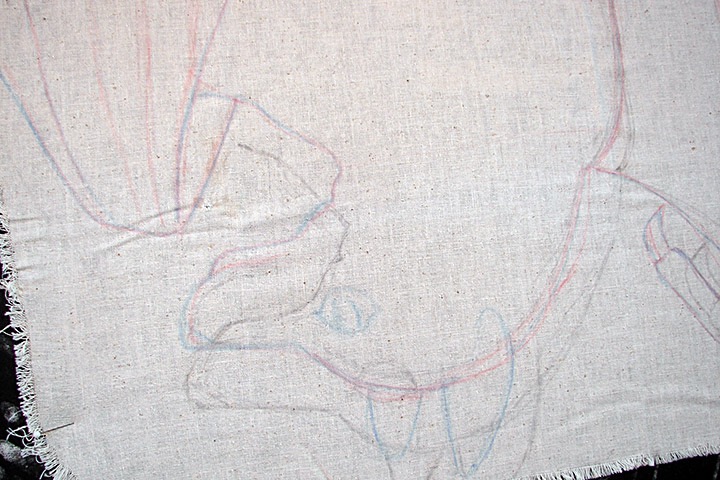
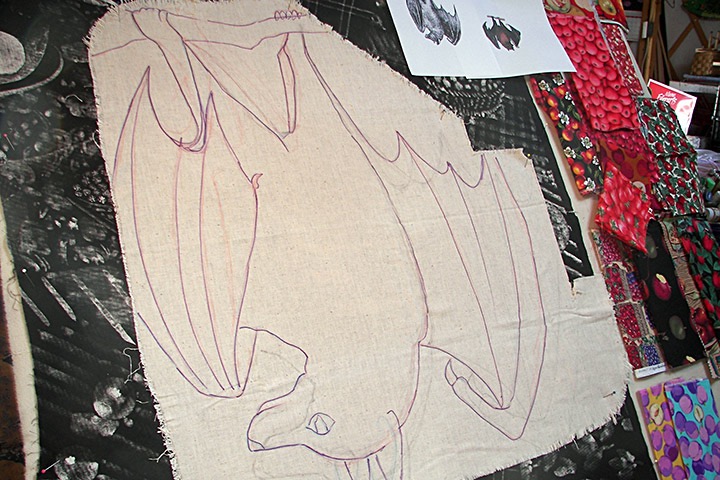
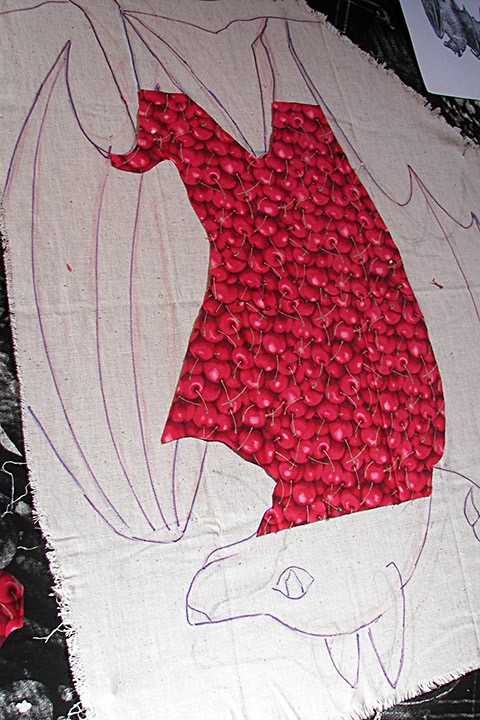
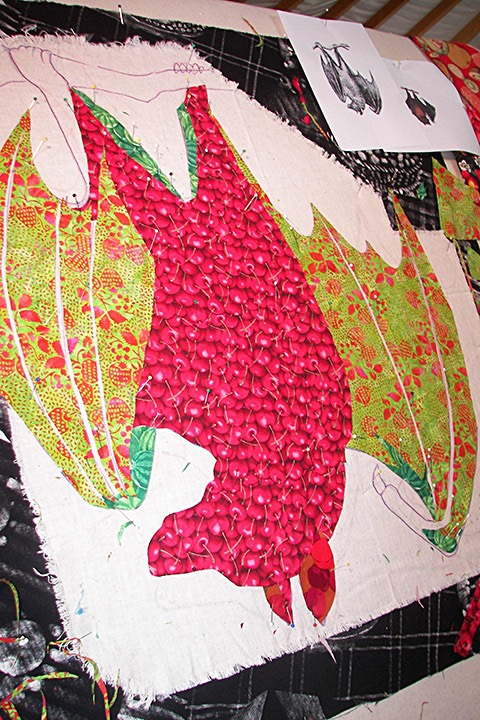
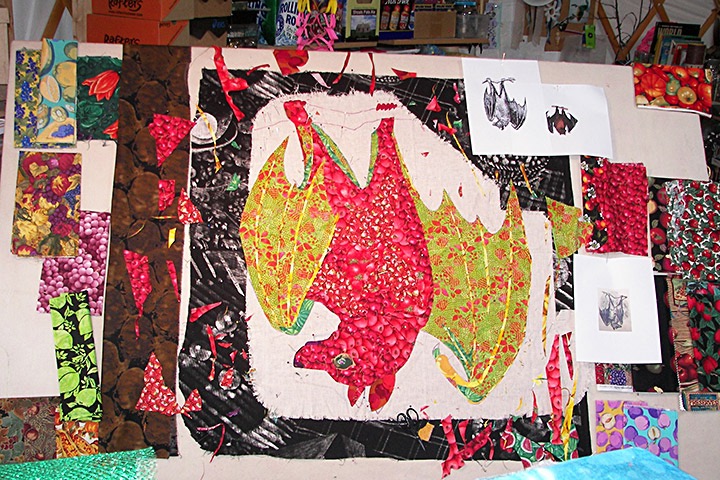
Oh I love your bats. All your art but this is so wonderful. I kind of wish there were bats to get our mosquitos! WonderfulFabulous!
Oh I love your bats. All your art but this is so wonderful. I kind of wish there were bats to get our mosquitos! WonderfulFabulous!
Oh I love your bats. All your art but this is so wonderful. I kind of wish there were bats to get our mosquitos! WonderfulFabulous!
I love the fruit bat and your quilt pays tribute to its effort. I appreciate your documentation process even though it is not as complete as you like it, for it becomes a teaching tool to all quilters. It makes me want to take the effort to take pictures of my process. The thought process is also so good – successful or not it helps me realize some things take more time than others, and perfection is really only our perspective.
I love your work, it is fun and, puts a big smile on my face that can last for hours. Thank you, thank you.
I love the fruit bat and your quilt pays tribute to its effort. I appreciate your documentation process even though it is not as complete as you like it, for it becomes a teaching tool to all quilters. It makes me want to take the effort to take pictures of my process. The thought process is also so good – successful or not it helps me realize some things take more time than others, and perfection is really only our perspective.
I love your work, it is fun and, puts a big smile on my face that can last for hours. Thank you, thank you.
I love the fruit bat and your quilt pays tribute to its effort. I appreciate your documentation process even though it is not as complete as you like it, for it becomes a teaching tool to all quilters. It makes me want to take the effort to take pictures of my process. The thought process is also so good – successful or not it helps me realize some things take more time than others, and perfection is really only our perspective.
I love your work, it is fun and, puts a big smile on my face that can last for hours. Thank you, thank you.
detailed presentation thanks very much for division thanks to learn a lot of useful advice, trying to realize it colored my dreams
detailed presentation thanks very much for division thanks to learn a lot of useful advice, trying to realize it colored my dreams
detailed presentation thanks very much for division thanks to learn a lot of useful advice, trying to realize it colored my dreams
a fascinating piece
a fascinating piece
a fascinating piece
Reading your content is big pleasure for me, it deserves to go viral, you need some initial traffic only.
If you want to know how to get it search for: blackhatworren’s strategies